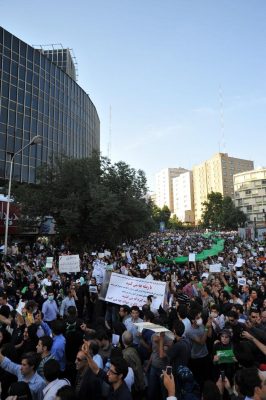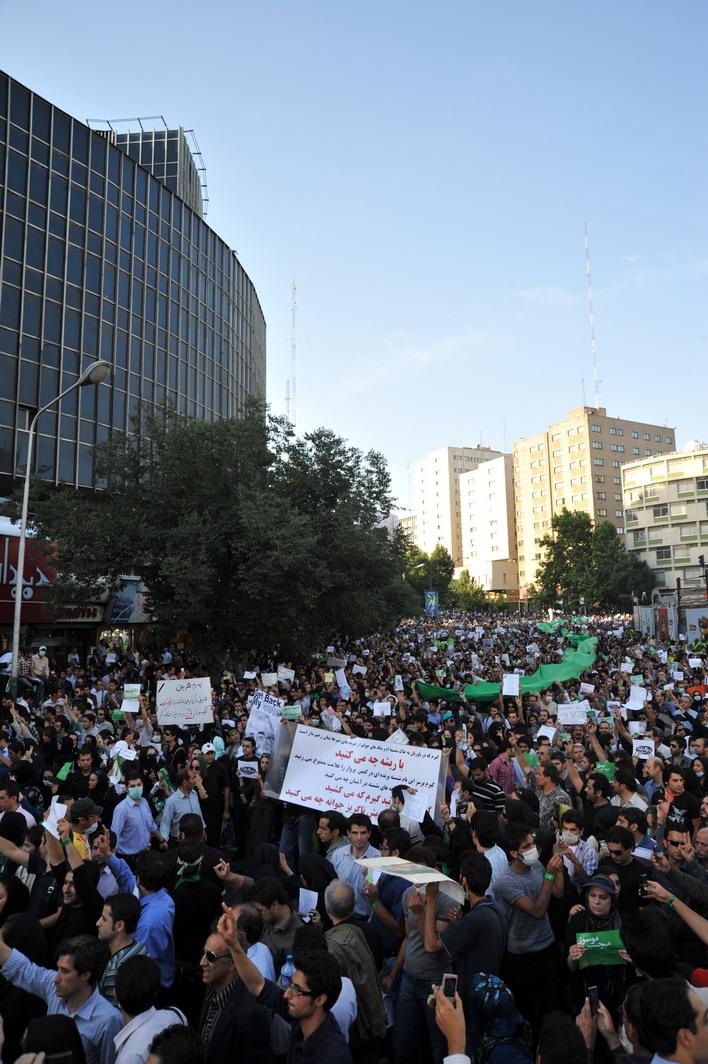 This past June, Iran was a major part of mainstream political debate in the international press. Much of the world rallied in support of Iran’s green movement, and condemned Mahmoud Ahmadinejad and Ali Khamenei for stealing the presidential election.
This past June, Iran was a major part of mainstream political debate in the international press. Much of the world rallied in support of Iran’s green movement, and condemned Mahmoud Ahmadinejad and Ali Khamenei for stealing the presidential election.
However, in the months that followed, coverage of the events in Iran dropped off as other hot topics captured the attention of Western media outlets, from the health care debate and Tiger Woods’ sex scandal to, most recently, the devastating quake in Haiti. The lack of coverage might suggest that things have been all quiet on the Iranian front. In fact, the country has experienced a whirlwind of political activity amid growing tensions between reformists and hardliners.
Yet there have also been signs of compromise. Unfortunately, U.S. policy toward Iran has encouraged polarization within the country and made a peaceful and democratic resolution to the crisis less likely.
After Ashura
The recent Ashura Day protest, during which security forces killed several protesters including the nephew of opposition leader Mir-Hosein Mousavi, was one of the largest and bloodiest post-election demonstrations. Likewise, the burning of Khomeini’s picture — allegedly by anti-government demonstrators — sparked enormous tensions on both sides, as hardliners and reformists alike accused each other of tarnishing the image of the regime’s founding father. These acts signified the increasingly unstable ground both proponents and opponents of the regime are standing on. Since the protests, both sides have opened lines of communication and dialogue. For the first time since before the election, live televised debates featured members of the opposition. Perhaps more significantly, one of the leaders of the opposition movement, presidential candidate Mehdi Karroubi tacitly recognized Ahmadinejad’s presidency,
While elements on both sides have made concessions and adopted conciliatory tones, rarely are Iranian politics so simple. Conservative hardliners and reformists have many difference voices. The televised debates as well as Karroubi’s statement have riled up various subsets of each camp, producing reactions ranging from skeptical to outright angst. Although supporters of the reformist movement reacted against Karroubi, opposition leader Mir-Hossein Mousavi has remained silent on the subject, preferring to let Karroubi himself explain his statement. Ultra-conservative Shariat-Madari, managing editor of the pro-government newspaper Kayhan, is suspicious of ulterior motives by Karroubi’s camp and rejects any notion of compromise or rapprochement.
Both Khamenei and the reformist leaders are well aware that continued tensions between their camps can be solved in one of two ways: through diplomacy and compromise, or through bloodshed. The economy may well determine the course of events. A recent World Bank report forecasted strong economic growth for the country in 2010 and through 2011, with oil sales producing a steadier revenue stream than in recent years. Iran has cultivated increasing trade links throughout Asia, the Middle East, and Europe. Iran’s youth — the median age of Iranians is under 35 years of age — are seeking economic opportunity, first and foremost. If Iran is to capitalize on its growth potential, hardliners and reformists alike must agree to come to the table and iron out their differences. If not, Iran will forever be mired in poverty and stagnation, or worse, face another revolution.
Keeping the Islamic Republic Islamic
Although protests have been raging since June 2009, major reformist leaders ranging from Mousavi himself to Mohammad Khatami have insisted that their goal is ultimately to preserve the Islamic Republic of Iran. As architects of the 1979 revolution, these men served as Ayatollah Khomeini’s lieutenants and helped him build the government they now rally against. Their call has softened since the election. Cries of “death to the dictator” and calls for the removal of Ahmadinejad from office have been replaced by more moderate calls for increased transparency and accountability in voting and governmental procedures, as Mousavi explained in his “17th Statement.” In fact, Mousavi’s admission mirrors that of the Iranian public at large, as recent PIPA polling has shown that a majority of Iranians also believe in the basic principles of the Islamic Republic, its stance towards the West, and its nuclear agenda. The primary argument of reformist thinkers is that conservative consolidation and Khamenei’s increasingly active role in Iranian politics is contrary to the underlying ideals of the Islamic Republic and the position of veleyat-i-faqih, or “guardianship of the cleric,” better known in the West as the Supreme Leader.
The regime’s policies, however, has fluctuated greatly. The government has shut down major liberal papers and journals, but at the same time reformist candidates such as Mousavi and Karroubi have retained and continued to update their official websites. The government’s willingness to soften its nuclear stance, in addition to its recent overtures to opposition members, suggests a continuing tension between hardliners and moderates within ruling circles.
Unfortunately for the country, one of the only constants has been the callousness of the judiciary and the brutality of the paramilitary volunteers, the Basij (which is dominated by right-wing fanatics). Ayatollah Ahmad Jannati, one of the heads of the Iranian judiciary, recently stated that the government should take an even harsher and more adamant stance on election protestors. The Ashura protests demonstrated the continued willingness of Basij forces to use any means necessary to silence the opposition. Just recently, an Iranian court sentenced 11 demonstrators to death — a chilling reminder that while some conservatives and hardliners have opted for diplomacy, real people are still suffering at the hands of state-sponsored forces.
Karroubi’s Recognition
After the June election and the official announcement of Ahmadinejad’s landslide victory, the streets of Tehran and hundreds of other cities throughout the country were filled with thousands upon thousands of angry protestors, chanting the now famous slogan “Where’s my vote?” The belief of opposition leader Mir-Hossein Mousavi was and has been that the election was rigged and Ahmadinejad’s government was illegitimate. Protestors went so far as to demand that Supreme Leader Khamenei should also be removed from power. Since the election, the opposition movement has grown. Mousavi, Karroubi, and Mohammad Khatami (the former reformist president) have formed a coalition of supporters and built an intricate network branching throughout Iran and its diaspora.
Karroubi’s recent recognition of Ahmadinejad as the president of Iran has sent shockwaves throughout the country. While he still believes that the election was rigged, he has affirmed his desire to support the position of veleyat-i-faqih. Karroubi and the reformist movement realize that Khamenei and the regime hold the key to ultimately advancing the cause of the reformists. From a historical point of view, Karroubi’s move is both very logical and deeply Persian. When the Arabs conquered the Persian Empire in the seventh century, the conquered became the conqueror — Persian culture and traditions eventually took root in Arab society. The same can be said of the Chinese and their Mongolian invaders in the 12th century. Iranians call this method of winning over one’s enemies through kindness and polite smiles tarof.
By softening the the regime’s hardline conservatives through tarof, the reformists can gradually begin to enact the change they seek. This is just the latest move in an intricate and slow-paced game of chess between the opposition and the hard liners. More moves by the opposition can be expected in the near future; Mousavi and Karroubi recently urged their supporters to show their support on the streets, albeit peacefully, on February 11 — the anniversary of the Islamic Republic. The anniversary of the Islamic Republic is perhaps the most important holiday in the country, and millions of people may well heed the reformists’ call.
Reactions to Mousavi’s call for reformists to take to the streets have varied. Friday prayer leader Ayatollah Emami Kashani urged his followers to refrain from divisive slogans and to celebrate the anniversary of the revolution peacefully. On the other hand, government agents claim that by sheer force of numbers pro-government demonstrators will deter reformists from protesting.
America’s Role
Washington’s policies toward Iran have been self-defeating. A recent move to increase American naval presence in the Persian Gulf, as well as expanding its missile defense system throughout the Middle East and Eastern Europe, has fueled anti-Western rhetoric in Tehran. There have also been increasingly strained debates in the UN Security Council as the United States continues to push for harsher sanctions against Iran. Russia and China remain adamant that sanctions should be limited to nonproliferation, and are likely to veto American attempts at a UN resolution.
The United States would have much to gain from a more moderate Iran. Yet Washington’s recent actions have pushed the regime even farther to the right. By continuing to press for crippling economic sanctions in an attempt to bully Tehran to cooperate with its nuclear demands, the United States is quickly isolating the country and destroying chances of dialogue.
Because of Iran’s unique position in the Middle East and its ability to influence other regional actors, increased moderation will allow the United States to finally begin the process of détente with the country after three decades of political standoff. A more moderate Iran would also increase the overall stability of the region as well as mutual economic opportunity between Iran and the West. By balancing nuclear concessions and the lifting of economic sanctions while at the same time encouraging the regime’s efforts at reaching out to the opposition, the United States can help push both sides closer together. The battle for increased transparency and moderation will continue long after the February 11 anniversary of the Islamic Republic and the United States has the necessary tools at its disposal to help enact real change in Iran.
